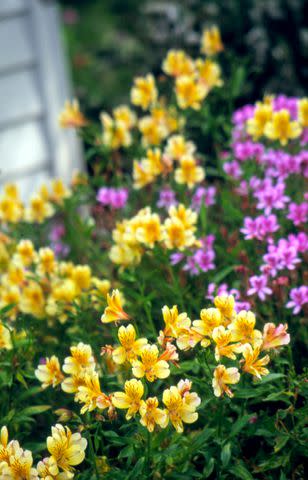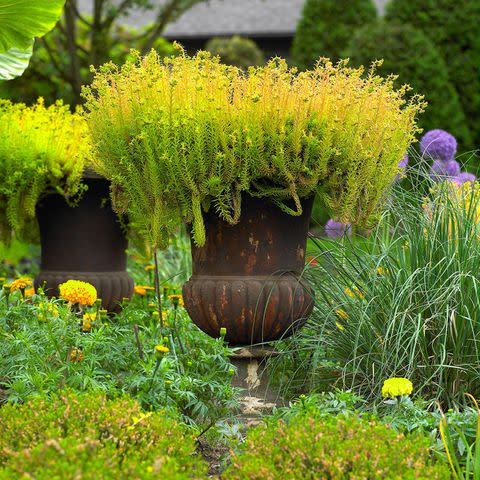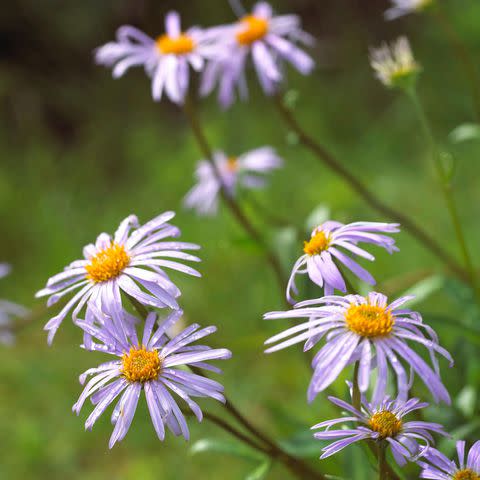How to Plant and Grow Alstroemeria
These long-lasting cut flowers come in an abundance of colors.

Edward Gohlich
Reviewed by Sylvia DuaxReviewed by Sylvia Duax
The cut flower of all cut flowers, alstroemeria is a staple flower for mixed bouquets. With blooms that last up to two weeks and a color palette almost as wide as the spectrum, these perennial plants started as a commodity for the flower markets before finding their way into home gardens.
The flowers of the alstroemeria are so interesting and diverse that they are often likened to orchid flowers. There is a huge variety of color combinations to choose from. including multicolored varieties with brushstrokes of color. The center three petals on these beautiful blooms feature streaks and speckles that are almost reminiscent of whiskers.
Alstroemeria is toxic to humans.
Where to Plant Alstroemeria
Find a location in full sun with moist but well-drained, slightly acidic soil to plant alstroemeria. Although they are mostly known as cut flowers, you don't have to limit them to a cut flower garden; they also look good in a sunny border in the company of other perennials and shrubs.
Tips
Alstroemeria is native to South America and has naturalized in the U.S. Although the plants have not been classified as invasive, they do have a reputation for spreading aggressively. Thoroughly dig up the tubers in unwanted areas. If you leave a single tuber behind, a new plant may regrow from it. Alternatively, plant alstroemeria in pots to contain their spread.
How and When to Plant Alstroemeria
The best time to plant alstroemeria is in mid-to late spring, around April or May, To plant a nursery-grown potted plant, dig a hole about twice the diameter of the pot and about the same depth. Place the plant in the center of the hole and fill in original soil to the top of the root ball. Gently tamp down the soil and water well.
Space plants 1.5 to 2 feet apart, depending on the mature size of the variety.
Alstroemeria Care Tips
Alstroemeria is easy to grow.
Light
For the best display of flowers, grow these plants in full sun. Many varieties tolerate partial shade, but they are much more likely to flop over and won't be as floriferous.
Soil and Water
Plant alstroemeria in moist but well-drained soil with a pH between 5.5 and 6.3. Because of their fleshy tuberous roots, alstroemerias are likely to rot in too much water. They thrive with consistent moisture, especially during flowering.
Once the plants are established, they tolerate short droughts without a problem. The tubers allow the plants to store nutrients and water for times of need. This allows the plants to deal with drought and other stressful periods better than most.
Temperature and Humidity
Alstroemerias are not winter-hardy below USDA Zone 6. Their ideal growing temperature ranges between 65 to 80°F. They do not have any particular humidity needs.
Fertilizer
When first planting alstroemeria, add a high-nitrogen fertilizer, such as a 12-4-8, to the top few inches of soil, following the product label directions. Fertilize established plants with a high-nitrogen water-soluble fertilizer in early spring to support blooming, casting it on the ground without it touching the plants. Follow the product information for amounts.
Tips
Instead of cutting the flowers from the stem, as you would other cut flowers. pull the entire stem out of the plant. Grasp a flower stalk at its base and pull it out. This method encourages the plant to form new shoots at the base. Cutting the stem halfway down can slow the growth of the plant. After pulling the whole stem up, cut it to the required length, remove any lower foliage if desired, and place it in a vase.
Potting and Repotting Alstroemeria
Alstroemeria makes a good potted plant; in fact, growing it in pots keeps it confined to its designated spot without spreading into unwanted areas.
Use a container with large drainage holes and fill it with a mixture of well-draining potting mix and compost. Keep in mind that container plants need more frequent watering than plants in garden soil.
Although alstroemeria is winter-hardy to Zone 6, growing it in a container exposes the roots to the cold. To winterize the pots, insulate them by sinking the container in the ground or by placing it in a second, larger pot to create a planting silo.
Repot the plant to a larger pot with fresh soil when the tubers have reached the sides of the container, or the roots grow out of the drainage holes.
Pests and Problems
Alstroemeria is susceptible to aphids, spider mites, whiteflies, snails, and slugs. When planted in overly wet conditions, it is susceptible to root rot.
To prevent flopping, which is especially likely with older varieties and varieties grown for cut flowers, provide some support or stake to hold up the tall stalks.
How to Propagate Alstroemeria
Over time, alstroemeria forms large colonies, and dividing the plants is not only an easy way to propagate the plant but also helps keep the colony's size within bounds. In the early spring or early fall, dig up the clump of tuberous roots and divide it into sections. Make sure that each section includes healthy tubers. Replant them in a new location at the same depth as the original plant and water well.
After being divided, the plant is slow to get established and some of the more temperamental varieties may take a year or two until they bloom again. That's why division is only recommended every few years.
Types of Alstroemeria
More than 120 species of alstroemeria produce blooms in colors of purple, red, orange, pink, yellow, or white, some of which are striped or speckled with other colors. There are also numerous hybrids.
Alstroemeria aurea

Alstroemeria aurea has yellow or orange clusters of lilylike flowers on graceful stems 2 to 3 feet tall. Zones 7–10
'Summer Heat'
Large flowers and tall stems on a plant growing 3 feet tall make this hybrid a favorite for cut flowers. The bright red flowers have a yellow central flare. Zone 6-9
'Inca Ocean'
This hybrid has bi-color lavender-blue flowers with lighter edges. It grows 8 to 12 inches tall and spreads 14 to 16 inches. Zone 7-9
Alstroemeria Companion Plants
Sedum

Sedums are nearly the perfect plants. They look good from the moment they emerge from the soil in spring and continue to look fresh and fabulous all growing season long. Many are attractive even in winter after their foliage dies and is left standing. They're also drought-tolerant and need very little if any, care. They're favorites of butterflies and bees. The tall types are outstanding for cutting and drying. There are many different types of sedum, from tall types that will top 2 feet to low-growing groundcovers that form mats. All thrive in full sun with good drainage. Zone 3-10
Aster

Aster flowers are the superstars of the fall garden. Some types of this native plant can reach up to 6 feet with flowers in white and pink but also, perhaps most strikingly, in rich purples and showy lavenders. Not all asters are fall bloomers. Extend the season by growing some of the summer bloomers also. Some are naturally compact. Others are tall types that grow more than 2 feet tall. Zone 3-9
Penstemon
With a rainbow of colors and hundreds of species to choose from, penstemon offers just as much diversity as alstroemeria. From dwarf alpine plants to prairie penstemons reaching up to 5 feet tall, there's a height for every part of the garden. These tough perennials stand up to intense growing conditions, including poor, gravelly soil. Zone 3-9
Frequently Asked Questions
Should alstroemeria be cut back for the winter?
No. Cutting back the entire plant for winter stunts the flowers in the following season. However, you can remove individual spent stems at the soil line after they die.
Are Peruvian lilies toxic to cats?
Alstroemeria (Peruvian lilies) are not true lilies and are not toxic for your felines.
For more Better Homes & Gardens news, make sure to sign up for our newsletter!
Read the original article on Better Homes & Gardens.